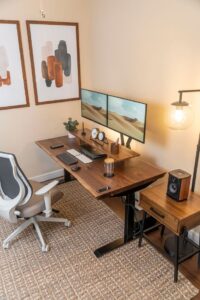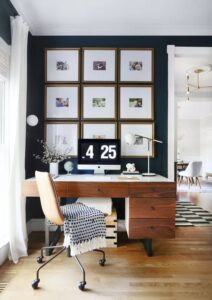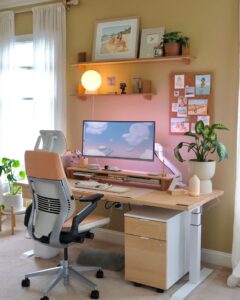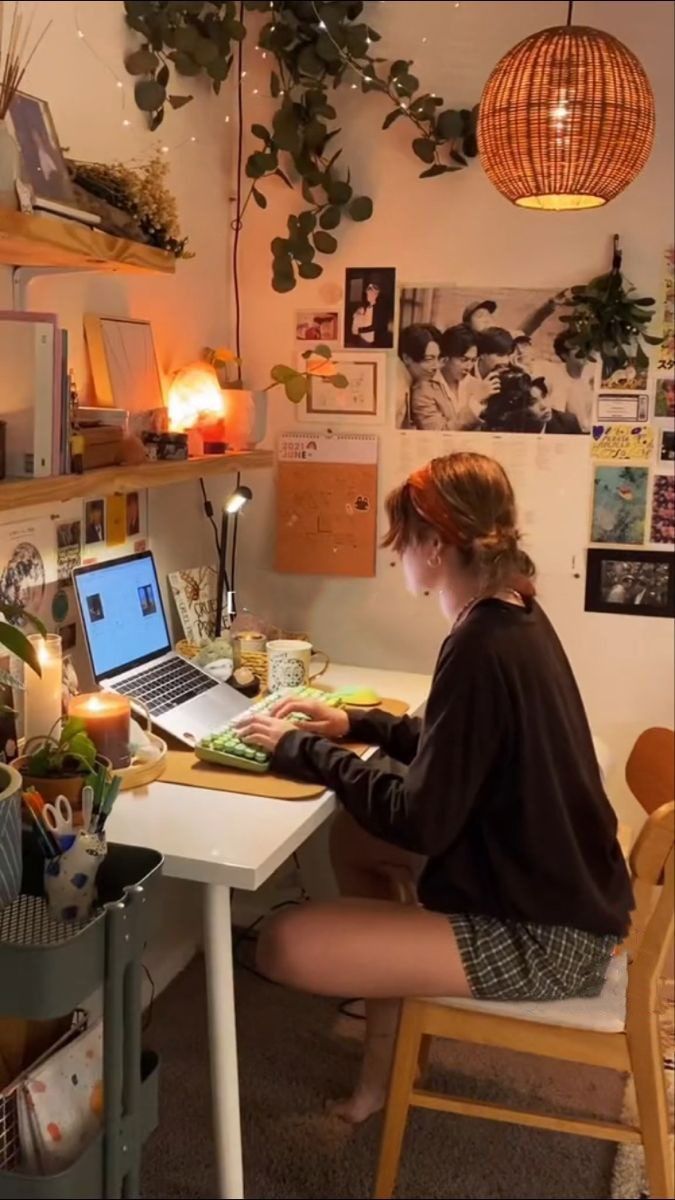In the past year, the traditional demarcation between our professional and personal spaces has blurred significantly. With remote work becoming the norm, many of us find ourselves toiling away on our laptops from the comfort of our couches or beds, making the delineation between work and home life increasingly challenging.
The crux of establishing an effective home office lies not in securing an exclusive room for it—a luxury that eludes most of us—but rather in crafting a minimalist, visually pleasing, and highly functional space within the constraints of your existing environment. However, if you’re yearning for a change and seeking a more organized and aesthetically pleasing workspace without the luxury of a separate room, this guide is tailored just for you. Embracing a thoughtful and space-saving approach to office room interior design can transform even the most limited spaces into efficient work sanctuaries.
Creating an Optimal Home Workspace: Minimalist Office Setup
Find a Space
The foundation of a minimalist office room design is selecting the right space. Look for an area that is spacious, away from the daily hustle-bustle, and receives ample natural light. Consider empty nooks near windows in bedrooms, studies, or entertainment rooms. Pay attention to the dimensions of the space, as accurate measurements are crucial for fitting perfectly sized furniture. This often overlooked aspect is essential for creating a harmonious and balanced layout.
Stay Neutral
Neutral colors play a pivotal role in minimalist design. Opt for a palette that includes whites, neutrals, and pale hues to create a clean and tidy appearance. Avoid intricate patterns and choose simple finishes to maintain a streamlined aesthetic. While neutrals dominate the color scheme, you can introduce a pop of color through carefully selected accessories, such as chairs or plants. This balance ensures a calming atmosphere conducive to focused work.
Pick Wooden Furniture
Wooden furniture adds warmth and character to a minimalist office room. It complements the neutral background and creates a pleasant ambiance. Two key pieces of furniture to focus on are the desk and office chair. For the office chair, prioritize durability, ergonomics, and style. Since the chair is a frequently used item, investing in a quality piece is essential. Choose a color that harmonizes with the walls and contributes to the overall aesthetic.
When selecting a desk, consider space-saving options such as floating desks, fold-out desks, or slim desks. These designs align with the minimalist ethos while providing functionality. Ensure the desk is sturdy, wide enough to accommodate essentials, and at an ergonomic height. The average study table height is recommended to be around 28 inches, with the chair at 18 inches, promoting a comfortable and efficient workspace.
Invest in Storage and Organizers
A clutter-free workspace is a hallmark of minimalism. To achieve this, it’s crucial to invest in efficient storage units and organizers. If your office lacks built-in storage, consider alternative solutions such as wall shelves, modular cabinets, or a combination of both. The choice depends on the number of items you use regularly and need in your workstation.
For those on a budget, makeshift storage using wooden, plastic, or cardboard boxes is a viable option. Creativity can be your ally in crafting unique storage solutions that not only serve a functional purpose but also contribute to the overall aesthetic of the room.
By having designated spaces for your belongings, you create an organized environment that promotes a clear mind and enhances productivity. Minimalism emphasizes the principle of “less is more,” and investing in suitable storage solutions is a practical step towards achieving this philosophy in your study space.
Get Plenty of Light
Lighting plays a pivotal role in setting the mood and energy of a room. In a minimalist study space, ample light is crucial to maintaining focus and productivity. Natural light is highly preferred, so choose a well-lit area for your workspace. If natural light is limited, supplement it with artificial lighting.
Consider adding a table or floor lamp to provide targeted light for your work area. Overhead lights can also contribute to creating a bright and inviting atmosphere. The goal is to avoid a dim or poorly lit space, as inadequate lighting can negatively impact your energy levels and overall work performance.
In addition to functionality, lighting fixtures can be chosen to complement the minimalist aesthetic. Opt for sleek and simple designs that align with the overall theme of the room. Striking a balance between functionality and aesthetics ensures that your study space is not only well-lit but also visually appealing.
Personalize Your Study Space
While minimalism emphasizes simplicity, it doesn’t mean your study space has to be devoid of personality. Personalizing your workspace is essential for creating a comfortable and inspiring environment. Consider incorporating artwork, accessories, and elements that resonate with you.
Choose a few key pieces, such as a poster, clock, rug, or plants, to add a touch of personality to your study space. These elements should contribute to a sense of comfort and motivation without overwhelming the room with unnecessary clutter. The key is moderation – limit the number of decorative items on walls, shelves, and the floor.
Artwork, in particular, can be a powerful tool for personalization. Select pieces that inspire you or have sentimental value. A well-chosen piece of art can serve as a focal point and elevate the overall look of your office room.
